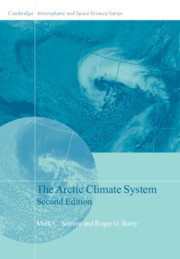Book contents
- Frontmatter
- Dedication
- Contents
- Preface
- Acknowledgments
- List of Acronyms
- List of Selected Web Sites
- 1 The Evolution of Knowledge about the Arctic and Its Climate
- 2 Physical Characteristics and Basic Climatic Features
- 3 The Basic Atmospheric and Ocean Energy Budgets
- 4 The Atmospheric Circulation
- 5 Energy Exchanges at the Surface
- 6 Precipitation, Net Precipitation, and River Discharge
- 7 Arctic Ocean–Sea Ice–Climate Interactions
- 8 Climate Regimes of the Arctic
- 9 Modeling the Arctic Climate System
- 10 Arctic Paleoclimates
- 11 The Uncertain Future
- References
- Index
- Plate Section
6 - Precipitation, Net Precipitation, and River Discharge
Published online by Cambridge University Press: 05 August 2014
- Frontmatter
- Dedication
- Contents
- Preface
- Acknowledgments
- List of Acronyms
- List of Selected Web Sites
- 1 The Evolution of Knowledge about the Arctic and Its Climate
- 2 Physical Characteristics and Basic Climatic Features
- 3 The Basic Atmospheric and Ocean Energy Budgets
- 4 The Atmospheric Circulation
- 5 Energy Exchanges at the Surface
- 6 Precipitation, Net Precipitation, and River Discharge
- 7 Arctic Ocean–Sea Ice–Climate Interactions
- 8 Climate Regimes of the Arctic
- 9 Modeling the Arctic Climate System
- 10 Arctic Paleoclimates
- 11 The Uncertain Future
- References
- Index
- Plate Section
Summary
Overview
One of the keys to understanding the Arctic climate system is the determination of freshwater transfers. As introduced in Chapter 2, the Arctic Ocean is characterized by a fairly fresh surface layer, primarily maintained by river discharge, the import of low salinity seawater through the Bering Strait, and net precipitation over the Ocean itself. This fresh surface layer allows sea ice to readily form. In turn, the major exports of freshwater are the ice and water fluxes to the North Atlantic through the Fram Strait and through the Canadian Arctic Archipelago. Following the water through the atmospheric, terrestrial, and oceanic branches of the Arctic hydrologic cycle, and assessing links between these fluxes, freshwater storages, and the global climate system is a vibrant area of research. But the problem cannot be tackled all at once. Here, the focus is on a large, yet digestible piece – precipitation, net precipitation, and river discharge to the Arctic Ocean. Aspects of the ocean branch will be examined as part of Chapter 7.
Precipitation is a difficult quantity to accurately measure in the Arctic. Evapotranspiration is even more difficult to obtain. Although annual average precipitation totals over the Arctic range widely, there is also strong seasonality. Precipitation over the Atlantic sector exhibits a general maximum during the winter half of the year, whereas elsewhere a warm season maximum is the rule. Annual net precipitation (precipitation less evapotranspiration, which can be assessed from atmospheric reanalysis data) is typically 150–300 mm over land, 150–200 mm over the central Arctic Ocean and more than 1,000 mm near the Icelandic Low. Although precipitation over much of the land area peaks in summer, evapotranspiration rates are fairly high, such that summer net precipitation is small or even negative in these areas. Over land regions, a considerable fraction of summer precipitation results from regional recycling of water vapor, pointing to the strong effect of the land surface. From autumn through spring, most of the precipitation is stored as snow. Consequently, river discharge to the Arctic Ocean exhibits a pronounced early summer peak as the snow melts. For much of the Arctic, river discharge is strongly impacted by the presence of permafrost which limits infiltration. The bulk of the river discharge to the Arctic Ocean is contributed by four major river systems: the Ob, the Yenisey, the Lena, and the Mackenzie. Discharge from Arctic draining rivers in Eurasia has exhibited a positive trend over the period of record, consistent with increased net precipitation as assessed from atmospheric reanalysis data.
- Type
- Chapter
- Information
- The Arctic Climate System , pp. 177 - 208Publisher: Cambridge University PressPrint publication year: 2014



